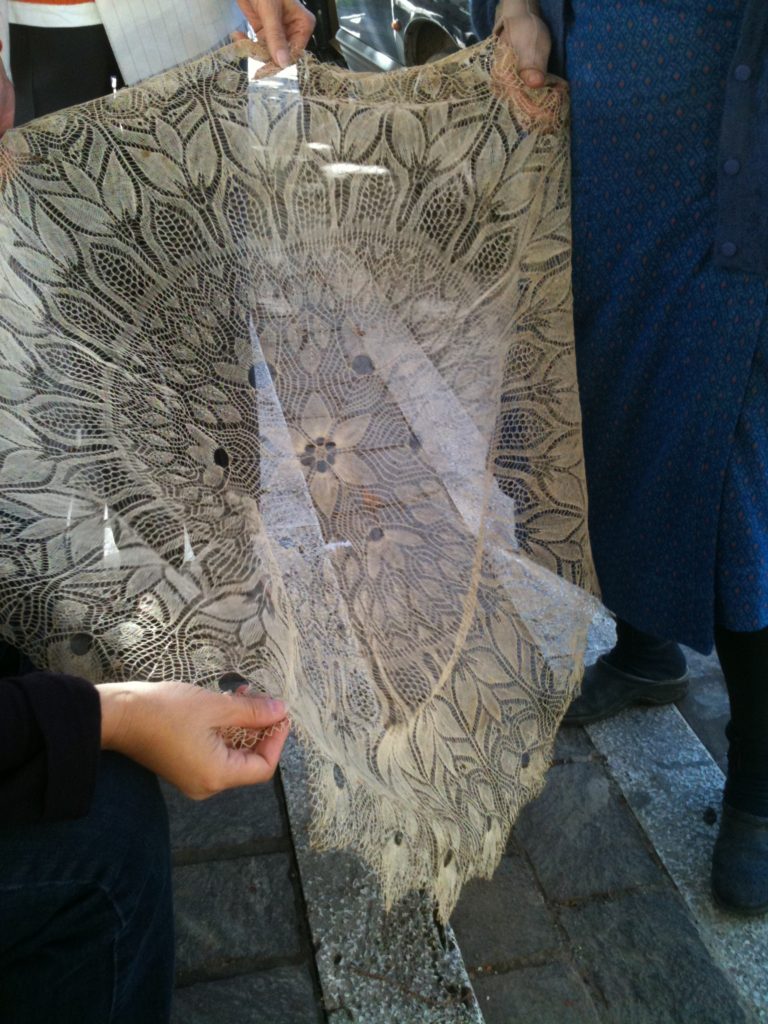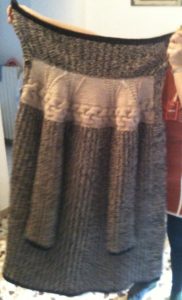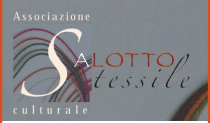I owe an enormous and long-standing debt of gratitude to a number of women about whom I intended to write years ago. Each went out of her way to serve as guide and storyteller based on my presentation of myself as a documentarian who would build on the gifts they freely gave. I owe them for extending themselves in service of the project I kept under wraps for years thinking it had to be bigger, grander, and in print. I want to give the wool community some idea of their gifts; and recognize them in the paragraphs below.
In June 2010 Sheep is Life in Tsaile, Arizona I met Ms. Irene Benally, who is featured regularly on the Peace Fleece site and whose maintenance and teaching of Navajo and sheep life is described in an article here. She graciously answered questions and explained about how the community was bringing back the churro sheep through selective breeding.

In the fall of 2010, I went to Italy looking for the knitted legacy of the women of Scanno, the remains of the stone sheep pen that formed part of the worship of Hercules at Alba Fucens, the rebirth of the heritage sheep breed Sopravissana, and the stone traces of wool roads in Puglia, still traveled by ragged men in old hats with sheep stumbling before them through the fields.
The crew at La Porta dei Parchi run a multi-faceted operation, manufacturing cheese, creating an adopt a sheep initiative, operating a restaurant with a bed and breakfast attached, and looking for markets for wool and organic products so that people who want to stay in the countryside can stay employed. Thank you to the whole family, who took the time to chat and moreover, knocked on doors and spread the word that an American wanted to ask the women of Anversa deli Abruzzi about their knitting.

Signora G. learned to cook from a neighbor at the age of five and made the daily meals thereafter for her family. She stood in her doorway to tell an American visitor about her life and her eyes lit up as the topic turned to knitting. She explained the instructions for the Calze Ferrate, knitted stockings with leather soles. She showed me downy white sleeves of even, tiny stitches she had made – and then insisted that I take them. We met another artist knitter who draped a delicate spider web shawl on the hood of a nearby car to show off the work, we met a virtuoso machine knitter who hand-finishes sweaters, and an Eastern European woman working in town who designed her own knitted creations.

Maria Luciana Buseghin drove my husband and me through the Tuscan countryside in a rainy chilly November, generously ushering us into an agriturismo honey farm for lunch, and off one of the select enterprises bringing back the Sopravissana sheep. One evening, she assembled the women of who had contributed to the Salotto Tessile, an informal network of women dedicated to the promotion of textile arts in Umbria. It was a chilly, rainy night in Todi, but a large group of women circled a table to welcome me: women who had been taught by nuns the fine work of cutwork embroidery, women who had created and knit for years and Dottoressa Buseghin herself, past curator at the Museo Tela Umbra of Città di Castello and founder of many textile-related education initiatives.
Signore Ezio Farina, photographic documentarian of traditional dress of Scanno women opened the Museo della Lana in Scanno, and gave a quick tour of the tools and samples of local handwork.
Signora P. at the Rifugio Larin in San Vito di Cadore, in the Dolomites, who took the whole of an afternoon off her chores to explain to me the changed ecology of the mountains since her girlhood to the point where there she had to purchase yarn from the sole remaining wool supplier in town in order to make the vests she knitted for her husband, the soft layer of her caring that he wore each winter next to his skin.
Acknowledgements
Cat Bordhi for believing in the project; I wish I had completed it during her lifetime; my father for co-writing the essay that go me into Cat Bordhi’s Visionary Retreat taking pictures, and everything else; the 2011 retreat cohort; Dr. Annette Annechild for more than I can say; Mary for her enthusiasm for all my endeavors; Felicia for formatting and unformatting over the years and constant support; EP for revitalizing this project; AP for the early seeds of inspiration (Lark Press Mitten book + Jerstorp/Kohlmark Textile Design Book), my friends, family, and long-suffering husband. I would also like to thank Captain Picard for his encouragement and marketing savvy so that this would eventually see the light of day.
Design, painting, and consultation by the extremely talented Jill Carter of JillCarterDesigns.com.
Thank you all.
